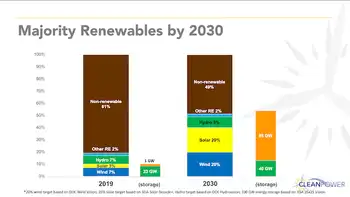Ebb and flow of wind power stress power grid
By Yakima Herald-Republic
Substation Relay Protection Training
Our customized live online or in‑person group training can be delivered to your staff at your location.

- Live Online
- 12 hours Instructor-led
- Group Training Available
Less than an hour later, it plummeted almost as much.
Sitting in front of 10 computer screens in a fifth-floor room of the federal Bonneville Power Administration headquarters in Portland, Kim Randolph had to react quickly.
Working from a keyboard, she diverted millions of gallons of water away from massive turbines spinning in Columbia River dams and sent it around the dams.
The 17-year veteran power operations specialist remembers how fast she needed to work as a wind storm caused generation to peak and fall three times over eight hours.
"You have to get it in hand and get it in hand very quickly," she said.
Getting it in hand is a balancing act. It means balancing the power generated by 31 dams, a nuclear power plant and now wind farms in order to send a stable flow of power into the BPA's 15,238-mile grid across the Pacific Northwest.
It also means balancing the grid's needs against those of fish and commercial river traffic on the Columbia River.
Getting power from wind, which can vary greatly, is complicating that balancing act.
In coping with the variations, the BPA has at times adjusted flows through dams at rates that exceeded guidelines established to protect fish.
"It is stressful. You have the threat of fish issues on one hand you are trying to prevent, and at the same time you're trying to meet load," she said.
The events of June 4 and 5 highlight the challenge facing the agency, utilities and wind generators across the region as wind farms sprout at a dizzying pace, much faster than anyone had anticipated.
From a humble start at 25 megawatts in 1998, wind generating capacity on the BPA grid galloped to 2,105 megawatts as of May this year, doubling in just the last 21 months. It's enough energy to power two cities the size of Seattle.
And there's more to come. Wind power on the Bonneville system could reach 6,000 megawatts within four years, according to agency estimates.
But the marriage of wind and water has begun to strain the system.
Fish need flowing water. Holding water behind dams when there's plenty of wind power reduces that flow and harms fish.
But sending enough water around the dam — not through the turbines — for fish reduces the ability to generate power that will be needed when the wind dies off.
By 2011, the agency estimates the system will run out of the capacity to adjust enough to accommodate for the variations of wind power.
As a result, the BPA, a nonprofit federal power-marketing agency, is accelerating plans for change, including: building more capacity, flexibility and quicker response times; implementing better forecasting tools; and sharing the responsibility for moving power within and outside the region.
"This issue is absolutely forcing greater coordination and collaboration among the region's utilities than just about any issue since putting in the hydro dams," said Elliott Manzier, Bonneville's senior vice president for corporate strategy. "The issue is much bigger than BPA. It is a Northwest issue."
Washington and Oregon are among the top states in the country for the amount of wind generation.
Wind turbines are concentrated along the east end of the Columbia River Gorge. Klickitat County has five operating wind farms, a figure that could grow to 14 when those planned or already under construction are included.
Kittitas County could be home to four wind farms in the near future. Yakima County is being looked at as a source of wind power.
Rachel Shimshak of Portland, executive director of the Renewable Northwest Project, a group that supports expansion of renewable energy, said three major factors are driving wind power growth.
The renewable energy standards imposed by the Northwest states require utilities to increase power generated from renewable sources.
Concern about climate change and moving away from fossil-fuel energy production also is a factor, she said.
Further, consumers are demanding clean energy. Utilities across the region, including Pacific Power, offer voluntary programs for consumers to purchase some of their energy needs from renewable sources.
Bonneville itself has been criticized for being slow to move away from its historic focus on marketing power from 31 hydroelectric dams and one nuclear plant.
Agency watchers say the BPA has struggled to deal with demands that wind generation poses.
Robert Kahn, executive director of the Northwest and Intermountain Power Producers Coalition, said the transmission system is antiquated and BPA needs to make changes.
"Wind power is forcing utility operators and policymakers to confront a lot of these long-standing problems," said Kahn, whose group is made up of thermal and wind generators.
Renewable Northwest's Shimshak agreed, saying after a slow start, Bonneville is now making great progress.
Part of that progress has been to charge wind generators using the system to finance some improvements. It is a move unprecedented anywhere in the country, Kahn said.
Pacificorp, which supplies power to nearly 130,000 customers in the Yakima Valley and Walla Walla areas, believes the accelerated wind plan appears to be a good one, a spokeswoman said.
"We think it is reasonable and will provide stability that will help us encourage and maintain wind development in the region," said Jan Mitchell.
One somewhat controversial element, planned for October, gives the BPA the ability to curtail wind production on what amounts to a three-strikes-you're-out stance. Wind operators who don't respond to agency requests to reduce output on three occasions run the risk of having Bonneville do it for them.
Kahn described the plan as draconian.
"We really hope it doesn't happen very often," he said. "It appears necessary but it could be draconian. One would like to think there is a better way."
One possible way is another element in the plan. As proposed, wind generators could pay coal or natural gas-fired plants to scale back production rather than asking wind generators to cut back.
Bonneville is also spending money to add 16 wind-monitoring stations to give wind operators better information on what the wind will be doing in order to respond quicker to changes.
And rather than set an hourly schedule for balancing resources and supply, Bonneville will institute a plan late this year to schedule power on the half hour.
That would help generators and people like the veteran scheduler Randolph.
"The more accurately we can forecast, the less reserves we have to have and that will lower the cost," she said. "It also lets us stretch the capacity of the hydro system to bring more wind to the system."











